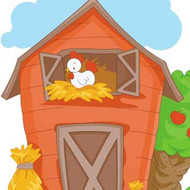Time Saving Tips for Chicken keepers
Keeping chickens does not have to take up all your time. In today's world, our lives are busy doing so many things. So here are a few top ideas which can make your Chicken Keeping more about enjoyment and less about time management. Easy, smart ideas which can be your go-to guide for Time Saving tips for Chicken Keepers.
Top ideas to save time in the chicken coop.
1. Install a Chicken droppings board
Keeping a clean chicken coop is very important for the health of your laying hens. Chicken faeces can spread disease and infection through the flock. It can be time-consuming to clean out the coop and if required disinfect it on a regular basis with Apple Cider Vinegar.
Generally, chickens prefer to roost up high at night. By simply placing a droppings board under the roost you can easily catch most droppings so they don't end up on the coop floor.
A droppings board is a board placed directly under the roosts. It catches overnight chicken poop. Installing a dropping board should allow you to reduce your serious coop cleaning time down to once a month. If your coop does need a good clean here read our popular blog article on the Best Ways to Clean a Chicken Coop Naturally.
Modern dropping boards are made using sheet metal or plastic. They work better than older style timber boards as they do not absorb liquid from the droppings. If you choose to use wood, put some old lino or vinyl over the top. Another option if using a timber board is using newspaper. Once soiled it can be put straight into the compost. Without question, using a dropping board is our number one idea for Time Saving tips for Chicken Keepers.

2. Use old mower catchers as nesting boxes
If you are into recycling then here is a time-saving tip you will love. Old grass catchers from push mowers are fantastic nesting boxes. The plastic ones are best as the fabric ones harbour bugs like mites and also lice.
Lawnmower catchers are enclosed and also dark, which the chickens love. Also, they are a breeze to clean.
How to use an Old Lawnmower catcher as a Chicken Nesting Box
- Just lift them out by the handle
- Tip out the spent bedding into the compost.
- Wash them out to remove parasites.
- Put in new bedding.
We also love grass catchers because when you have a mother hen, you can lift the whole catcher out at night and resituate her in a breeding pen without even waking her up!
If you're lucky, grass catchers will just slot into your existing nesting boxes. Or you can line them up along a shelf in the chicken coop. Install a droppings board above if the shelf is under the roosts. You can also install a few 2 x 4s and make a rack, but as not all grass catchers are the same size, this requires some planning.
3. Line your nesting boxes with old newspapers
This is one of our Time-Saving favourite tips for Busy Chicken Keepers.
Use a couple of whole old newspapers to line the bottom of your nesting boxes. Some keepers use plastic pads but newspaper work just as well. A thick layer of paper is very cushioning. So even if your chooks scratch out most of the nesting material, their eggs still have a soft landing and are less likely to crack or break. Also, a layer of paper makes cleaning the nesting boxes a lot less time-consuming. Just bundle up the paper as well as old bedding, and place in the compost.
The newspaper will pay off the next time your chooks step on an egg or decide to use the nesting box as a toilet.
4. Consider a deep litter system
Deep litter systems are a commitment with a steep learning curve. They are not suitable for all chicken coops. But if you decide to go down the road of implementing a Deep litter system for your chicken coop, it shall reduce coop cleaning to a once- or twice-yearly job.
In a deep litter system, you start with 15-30 cms of high carbon bedding material on the floor of the coop. It should be something dry and brown. Paper, straw, sawdust, wood chip etc. Pretty much anything except hay, lucerne or grass clippings which has too much nitrogen. Then whenever you can smell ammonia, or the coop looks dirty, you add another few inches of bedding.
The system is essentially a self-turning compost pile without food scraps, so no botulism. The bedding plus the chicken manure has the right carbon to nitrogen ratio for composting.
Your chickens provide aeration by turning and scratching around in the litter. Once the right bacteria is established in the coop, the compost makes itself, and all you have to do is keep adding more bedding. Then shovel it out every six months or so.
It sounds simple, but you need to get the right C:N ratio. You also need the right bacteria going and keep the coop environment balanced for the compost and the chickens. This means not too wet or dry, hot, cold or humid.
Deep litter systems are better suited to cooler areas where they also provide some warmth in the coop during winter. Do your research, try to find someone in your area with deep litter success and count on a bit of trial and error before the system gels. Just keep thinking of how much time you save as a chicken keeper when you clean the coop every six to twelve months.
5. Get an Automatic Chicken Drinker
There are a number of options when considering a Chicken Waterer for your -Chicken coop. You can look towards a Do it yourself Mains pressure Watering System. This is perfect for large flocks especially if you do not have time to top a waterer system up. Another option a is purchasing a couple of the Dine A Chook Chicken Waterers. Depending on how many you purchase and also how many birds are in your flock, the Dine A Chook Chicken Watering System could allow you the time to go away for a week or two without worrying about your chickens being hydrated. Just remember they also need food.


